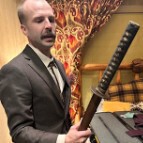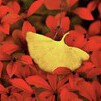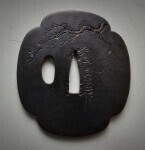All Activity
- Past hour
-
Thanks Hoshi. This was always going to be the defining aspect. I think I can see enough of the jihada with its characteristic Shintogo school chikei to move forward. The blade really needs some experienced eyes on it after a window has been opened.
-
Here is a signature from the DTI catalogue a few years back. Tokuju Shintogo, although most likely a daimei work with the Kuni and Mitsu characters being those of students, probably Kunihiro. Of note, there are only a small handful of Shintogo Tanto in the NBHTK’s records where daimei can be ruled out, if you take the latest opinion on the master’s authentic signature. Approving a new Shintogo is a big decision. The NBHTK will not validate it unless the workmanship is up to par, and this means it must be in a decent level of polish beforehand. As you can see with the image I posted, the mei is rather close. Note the radical stroke direction on the Mitsu, and the shape of the various elements on the Kuni. Keep in mind that the inclined mid-line on your Kuni is the biggest question mark element, although there is some very rare precedent for it but only in the old Kozan Oshigata (and the mei therein are approximations...) as you can see in the attachment. If the quality and features are aligned with Kunihiro, and with this type of mei material as supporting evidence, you have decent-good odds of it being accepted. However, if the quality and the features of work, once revealed by the polish, are not up to par or leave areas for doubt, it is unlikely that they will expand the canon on acceptable signature variation. As next step, I recommend to take a pen and replicate the mei while marking the stroke direction on every character, then compare with a corpus of Shintogo mei that you assemble in the course of your research. Good luck on your quest.
- Today
-
The red kanji on the report says "There is room for research in the inscription". In other words come back when you can convince us in a way that makes sense why the Mei is atypical. I think I am progressing in the right direction. Is it possible no one thought daimai-daisaku was a plausible explanation, especially given the date? This is why I was looking at old threads for 2018/19 Shinsa results to see if the panel were particularly cautious those years. I believe I'm correct in saying that when Tanobe sensei left, the NBTHK lost a bit of its mojo. I'm pretty sure a Horyu result can have a variety of different recommendations.
-
SOLD---Hawley 1st edition Japanese Swordsmiths Vol. I and II Sword Book
Gendaito59 replied to Gendaito59's topic in Books
SOLD -
After looking up a few threads on Horyu papers and meanings. What is the difference between a Horyu result and a To mei ga aru result? To mei ga aru at least papers so is it: "we're not 100% sure so we leave a footnote but will still paper the blade" and horyu is "we can't come to a conclusion at all?"
-
-
Rob Wolfe joined the community
-
Nakago = 14 cm Nagasa = 41 cm Mihaba = 2.8 cm Kasane = 0.7 cm Torii Sori = 1 cm
-
Kiipu started following An Interesting (if Troubled) Zoheito
-
Need your expertise on wakizashi.
Tohagi replied to Nazar's topic in General Nihonto Related Discussion
Tachibana Yasuhiro (from kyoto yamashiro) is quite a big name. Even without seeing the meï I really do not think this waki worth that money. You've been smart to take an advice here ! Best, Eric -
Makes sense. Thank you very much.
-
An Interesting (if Troubled) Zoheito
charlesf replied to Kaigunto230's topic in Military Swords of Japan
Do the mounts have to be original WW2 fittings?I have bought Chinese repro katana saya that are an almost 'universal' fit and serve the purpose of housing blades for which I either don't have mounts or the mounts are unsuitable (metal saya with wooden liner destroyed). Whilst not authentic they can provide a storage solution. Regards, charlesf -
I'm excited to see this when you get it in hand and after a fresh polish in Japan!
-
SCJapan joined the community
-
Redefining yokote is a normal part of a polish. This assumes no other damage and enough material left.
-
Dear Lewis B, This is Setsuko Chano ( 茶野 節子) I found your post yesterday fortunately. Regardeing a photo of Saya ( 鞘〉I found Dr. Roretz Jananese name老烈先生. I think that it seems to be able to idntify Number 2472 (75) in the list, "Aoje Sujeh, Provinz Boshin 2? lang gekurzt. Scheide weiss. Geschenk des Hara Kikohiro". Would you agree with my thoughts on this ? As you are German, you could read a short explanation about Japanese swords written by Dr. v. Roretz in the list. Dr. Roretz collected most of swords in Nagoya in 1876-1880. He learnt the evaluation method from Ozaki Tadakage 尾崎忠景( belonged to Owari Clan ) accoding a book written by Prof. Shoji Katoh of Nagoya University. I contacted Professor Katoh to get the souce of Ozaki Tadakage as a sword sevaluator. Because Ozaki Tadakage's name is not found as Swords evaluators name lists at present. As a Owari Cran, I found some records on him in our history. I would be grateful if you would let me know contacts of the person in charge when you have visited to Styer MesserMuseum in 2024. I shall go to the museum this August together with my husband and descendants of Dr.von. Roretz. They know the direktor of the Museum. Looking forward to hearing from you soon. Kind regards, Setsuko Chano
-
Welcome to the forum Kyle @PhillyKid53! Nice to see new members interested in Yari. Best of luck in your journey! -Sam
-
Worth reading http://www.nihontomessageboard.com/articles/sword_law.pdf
-
I will try some small pieces of paper, yes this my Nagamitsu in your files.
-
New Member Introductions
PhillyKid53 replied to Dusty62's topic in General Nihonto Related Discussion
Hell, my name's Kyle, and I'm eager to learn more about Yari/Nihonto. I've already learned quite a bit from the archived posts, looking forward to learning even more. Thanks all in advance. -
2devnul started following Wakizashi Fake or not?
-
Hi, Nakago looks legit. However, maybe it is due to the pictures, Sugata and Kissaki seems odd. Especially for early EDO (I agree with @ROKUJURO , based on patina color of Nakago). Like I said, it might be the pictures, but also could be a school that I'm not familiarized with. What are the measurements?
-

An Honest Type 95 I Couldn’t Pass Up
Scogg replied to Kaigunto230's topic in Military Swords of Japan
Bruce is correct, it's definitely an old myth. Iijima in particular seems to have produced "pattern 2" swords until near the end of the war, while other arsenals transitioned to "pattern 3" earlier. It's easy to assume "pattern 2 is earlier than pattern 3", but it really depends on the specific arsenal and company. All the best, -Sam -
Here's another odd hamon...a chicken pox gunome?
-
PhillyKid53 started following A (Yari) question on authenticity and build technique
-
First and foremost, apologies for any apparent ignorance in advance. I've seem to have come to a head on information regarding how exactly the Tachiuchi segment of the ebu is constructed. The Dogane in all examples I've been able to observe appear to be slid into place along the shaft and affixed into place by some combination of lacquered rattan or cordage. But, the wider segments between Dogane appear to be a different material proud of the parent wood. are those segments mottled lacquer or some kind of adhered and bound cloth? Any info would be a great help Images from imgur are for an ebu that lead me to inquire at all. The overall length, the general appearance and fitment draw to question it's authenticity, but I'm just as confident in being wrong as I could be right. I'm more than happy to provide any and all info requested, or better images if needed. https://imgur.com/a/0B9sUrQ -Kyle D.
-
2devnul started following What type of hamon is this?
-
Anything can be faked, I've seen false NBTHK (much harder to make then a simple Torokusho). That blade looks totally fake/replica. I wouldn't buy it, unless I'm looking for bush-cutter for 100$.
-
I have often heard that the tsuka wood can dry out and shrink over the decades. Maybe this is what happened in this case? What about the idea of folding small pieces of paper to stuff underneath the loose places? Side question: Is this on your Nagamitsu blade I have on file?
-

An Honest Type 95 I Couldn’t Pass Up
Bruce Pennington replied to Kaigunto230's topic in Military Swords of Japan
It is an old myth that the steel fuchi and tsuba were late war. Richard Fuller has a brief chart showing them seemingly randomly scattered throughout the serial numbers. On that, though, @Kiipu might have a more specific answer.










